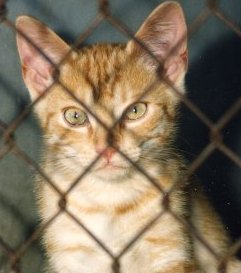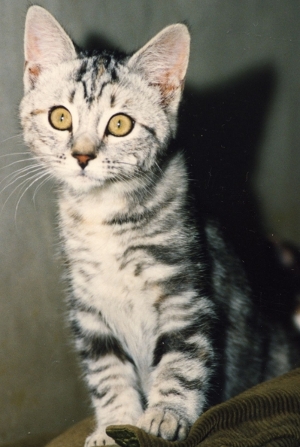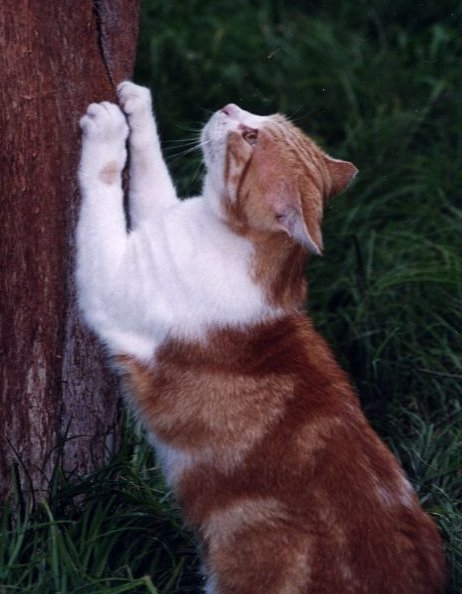 Some governments have introduced, or are considering, harsh laws to control cats. These include:
Some governments have introduced, or are considering, harsh laws to control cats. These include:
- Registration and limiting cats per household
- Compulsory identification
- Compulsory desexing
- Compulsory confinement and night curfew
- Cat-free zones
Underlying this approach is the belief that if restrictions are applied to owned cats, all other cats can be caught and killed, and any cat-related problems will magically disappear.
It is assumed that:
- all cat owners will comply with the legislation
- compliance can be checked
- all unowned cats can be caught and killed.
All these assumptions are wrong.
Killing unowned cats

Catching cats is time consuming and difficult, so it is unlikely that all cats will be caught. New cats will move into territories that have become vacant, and together with those remaining will continue to breed, so before long the population will be back to where it was. Decades of killing foxes has shown that eradication doesn’t work, since the fox population has not been reduced in the long-term.
During the time when there is a temporary reduction in cat numbers, immediately after a trapping/killing effort, rodent populations can increase due to the removal of a major predator.
If baits are then laid to kill the rats and mice, wildlife is endangered either by eating the baits directly, or by eating poisoned rats and mice. In New Zealand, a wide range of birds have been found dead after the use of an anticoagulant rat poison (1).
An experienced bird carer in Adelaide reported that a whole family of owls died after eating poisoned mice.
The restrictions designed to identify and confine owned cats impose a severe financial burden on the most disadvantaged sections of society, and undermine positive initiatives to control cat numbers.
Registration and limits on cat numbers

Registration has been introduced in Victoria and has been linked to a limit on cat numbers. So, all owned cats must be registered, but each household can only register 2 cats. There are a number of problems with this approach:
-
- The limit fails to take into account the owner’s facilities. For example, each unit in a block of 6 flats can have 2 cats, making a total of 12 cats, whereas a person with a large backyard can only have 2 cats.
-
- Registration does not make irresponsible owners into responsible ones. People currently doing the wrong thing by their cats and the neighbourhood simply won’t register their cats, and nothing will change.
- People with more than 2 cats may either hide them, or let them roam, rather than taking them to almost certain death at a shelter. Roaming cats will continue to breed.
- People who through the kindness of their heart feed stray cats can’t get them registered if there are more than 2. Here lies a major problem with this approach: if the cats aren’t registered, they won’t be taken to the vet to be desexed. So, these cats will continue to breed. People who take pity on strays in the first place are unlikely to send them off to be killed, so the problem of undesexed cats is inevitable under the Victorian legislation.
It is impossible to verify registration and cat numbers. Cat are not like dogs; they are small, they are excellent climbers, they can hide and they don’t bark. It would be impossible to prove how many cats live in a house. Identification of registered cats raises further problems (see below).
Identification

Cat collars and tags can pose a risk to active cats. There have been cases of cats being hanged or strangled when collars get caught, or injured by getting jaws or legs caught in collars.
Some cats are very good at removing collars, leaving them unidentified. Cat bells do not necessarily save wildlife because a quietly stalking cat does not ring the bells.
Microchipping is useful because animals who reach a vet or animal shelter can be reunited with their owners.
However, to make microchipping compulsory is a major financial burden on low income earners.
There is also a problem of verification; unless cats are friendly with strangers, they have to be trapped in order to be scanned and scanners don’t read chips through the wire cages.
Compulsory desexing

All cats should be desexed, so compulsory desexing sounds like a good idea. However, it fails to take into account the financial burden imposed on low income sections of society, such as pensioners. It would be rather pointless to fine such people for not having the money to have their cat desexed.
It is also difficult to verify whether or not a cat has been desexed. This information could be recorded on a microchip, but microchipping adds to the financial burden.
With both microchipping and ear tattooing a cat has to be caught to be inspected.
Some cats won’t allow strangers to pick them up, so they would have to be trapped. Hard to handle cats in cages cannot be scanned through the wire.
According to a REARK survey in 1994 (2), 92% of cats in Adelaide, including juveniles, are desexed, the highest of any capital city.
To get an even higher percentage desexed, more can be achieved through education and assistance than through unenforceable laws.
Confinement and night curfew

It is desirable for cats to stay in their yard and to be inside at night for their own safety. They are then less likely to be hit by a car.
However, to make confinement in the yard compulsory is absurd. Unlike dogs, cats can climb trees and trellises, and can jump over fences. Therefore there is a substantial cost involved in erecting a cat-proof fence.
Will the government pay a “fence subsidy rebate” to people like pensioners, who depend on their feline companions, but don’t have the money for high fences?
Also cats are naturally free-ranging animals that do not adjust well to permanent confinement in small areas.
Compulsory night curfews create unnecessary difficulties for people whose working hours don’t allow them to get their cat inside by dark.
There is also a problem of policing. How can it be verified whether or not cats are inside?
Cat-free zones

Some governments and councils want to ban cats in environmentally sensitive areas. However, to achieve a cat-free zone would require a cat-proof fence to be built. Nature abhors a vacuum, so if there are vacant territories, cats will move in anyway. Then endless trapping and killing will ensue, as these unowned cats breed. Wouldn’t it be better to have a minimum number of managed, desexed cats to defend these territories?
In conclusion, governments should not introduce restrictive legislation, imagining that it will solve cat-related problems. It won’t. Neither should governments impose specific cat management strategies on local councils. This approach locks councils into a course of action which is costly, difficult to police, unpopular with a substantial proportion of rate payers, and a nightmare to administer.
It is far better to allow councils to decide on the method of cat management most suited to their area. Some councils have already supported the education/low cost desexing approach advocated by C.A.T.S., and have achieved results that are both cost effective and popular with residents. These councils include Unley, Norwood, Payneham and St Peters, Campbelltown, Burnside, Port Adelaide Enfield, Holdfast Bay and Salisbury. See Humane cat management
References
- Eason, C., Murphy, E., Wright, G. & Spurr E. (2002). Assessment of risks of brodifacoum to non-target birds and mammals in New Zealand. Ecotoxicology, 11: 35-48
- REARK Research (1994). Research Report on the Metropolitan Domestic Cat: A Survey of the Population Characteristics and Hunting Behaviour of the Domestic Cat in Australia. Petcare Information and Advisory Service, Melbourne